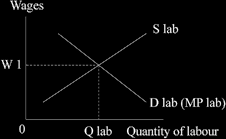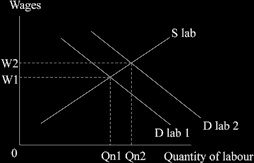| Home | Revision | A-Level | Economics | Labour Markets | Determining the equilibrium wage |
Determining the equilibrium wage
Equilibrium wages: putting together the supply of and demand for labour.

All the normal supply and demand analysis works!
• An increase in demand for labour means an extension up the supply of labour curve, an increase in wages and an increase in the quantity of labour hired.
• A decrease in demand has the exact opposite effect.
• An increase in the supply of labour means an extension down the demand curve for labour, a fall in wages and an increase in the quantity of labour hired.
• A decrease in supply has the exact opposite effect.
What can cause a shift in the demand for labour?
• When labour becomes more (or less) productive it moves the marginal revenue product curve out (in).
• When the price of a substitute or complement changes. If a substitute for labour gets cheaper (e.g., a particular machine), there will be a decrease in the demand for that type of labour.
• When the demand for the product in the market alters. An increase in the demand for a product means an increase in the marginal revenue product of labour. (When in perfect competition, marginal revenue product is the physical MP multiplied by the price; if competition is less than perfect, it will be the physical MP multiplied by the marginal revenue).
An increase in the demand for a particular product leads to an increase in demand for labour to make that product (“the demand for labour is a derived demand”).
• An increase in the demand for a good or service leads to an increase in its price and quantity.
• The increase in price is an increase in average revenue and marginal revenue.
• This means more workers will be taken on and there will be an increase in wages for everyone ( extending up the normal supply of labour curve).

What can alter supply curve of labour? Lots of things, including:
• A change in the wage offered elsewhere in an industry that workers know about and can move to.
• A change in non-monetary rewards either in this industry or else in an industry the workers know about and can move to.
• An increase in the number of people reaching 16 years of age (or whatever age people join the working population). This would reflect an earlier change in the birth rate
and the cohort of children is now coming through.
• More and better education in the skills needed in that particular industry.
• New retraining schemes by government, business associations, trade unions and the like.
• Immigration and emigration.
• Social changes, e.g., if it suddenly becomes acceptable for women to work in general or in a particular industry.
• Changes in death rates, war, disease, medical advances, public environmental improvements and the like.
NB The move to a new equilibrium may not be instant – it can take a long time to learn new skills or retrain – for brain surgeons it takes years! So we can often see a shortage of a particular group of workers, like doctors, nurses, or teachers. In the case of public service workers, the shortage may be because society pays low wages, below the equilibrium level to attract good people.
Shortages may appear and persist for several different reasons:
1. There is disequilibrium because of wage fixing (by the government or a trade union).
2. Lags in adjustment (these are common).
3. There are various special reasons for labour immobility, which are often social
(more later!).